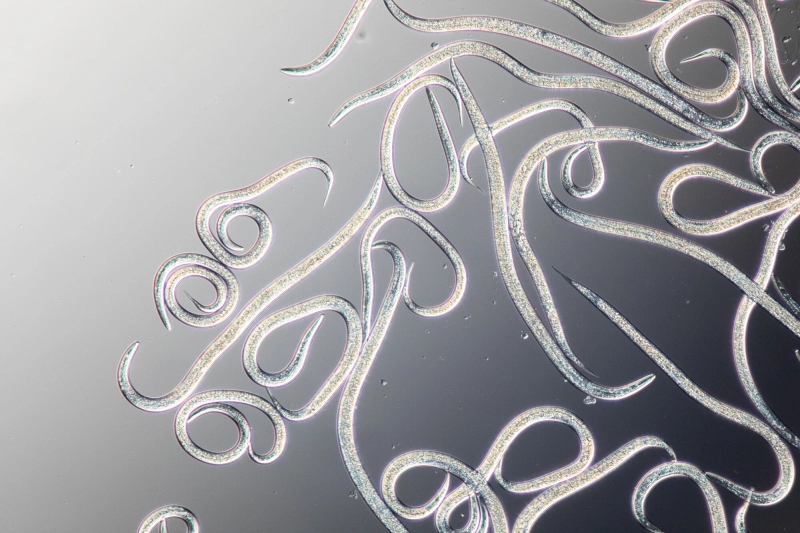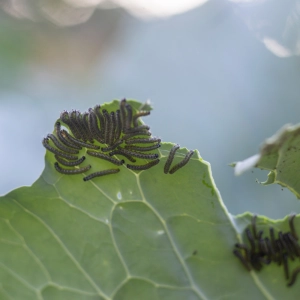If you’ve experienced holes in leafy greens, unexpected low yields, spoiled fruit, stunted growth, scarring and discolouration in your fruit and veg plants, then the chances are there’s a pest at play – either in the soil or on the plants themselves.
The most common pests affecting the quality of our fruit and vegetables in the UK include:
- Carrot root flies - feeding on roots and causing wilting, discolouration to outer leaves, stunting and occasionally complete plant loss.
- Cabbage root flies - feeding on the roots and lower sections of plants leading to stunting, reduced yield, yellowing leaves and sometimes complete plant loss.
- Onion flies - feeding on the roots, leaves and bulbs of a range of plants from the onion family including onions, leeks, garlic and alliums - causing yellowing wilting leaves, and often killing rows of seedlings.
- Sciarid flies - eating through the roots and low stems of young plants which can go on to cause rot.
- Cutworms – damaging crops by severing roots at ground level.
- Shore flies - transmitting plant diseases rather than feeding on the plants themselves and affecting produce grown in a greenhouse. They will deposit frass on the leaves and flowers of fruits and vegetables which can cause cosmetic issues.
- Caterpillars - eating the leaves and young shoots of a variety of fruit and vegetable plants. They have the capacity to eat through a large volume of plant material and can easily decimate an entire plant. They can also destroy the flowers, fruits and growing tips of plants, and leave frass behind spoiling the cosmetic appeal of produce.
- Gooseberry sawflies – generating larvae that will feed on the leaves of gooseberry and red/white currant plants, reducing fruit yield.
- Thrips - feeding on all parts of the plant with the young larvae usually starting on the underside of the leaves. Damage includes stunted and distorted growth, scarring and discolouration.
- Codling moth caterpillars - damaging a range of fruit including apples, pears, quince and walnuts. They will feed inside the developing fruits making tunnels and leaving excrement on the outside of the fruit. Affected fruits can be distorted, stunted and discoloured, and often drop early.

Natural predator controls
Natural predator controls (also known as biological controls) are non-chemical treatments that rely on the natural enemies of pests.
The natural predator of these fruit and vegetable pests are nematodes, including the species Steinernema feltiae and Steinernema carpocapsae.
Nematodes are naturally occurring microscopic worm-like organisms, and they can be very successful in controlling fruit and vegetable pests.
Nematodes will actively seek out caterpillars and larvae, then feed and multiply inside them, infecting them with a bacterium. Once infected, the larvae and caterpillars will stop feeding and die. The nematode will then go on to seek out more, repeating the cycle.
These natural predators are a safe treatment and are ideal for organic gardeners. Nematodes can be used on all home-grown produce with confidence as they leave no chemical residue – crops can simply be rinsed with water before eating.
When and how to apply biological controls for fruit and vegetable protection
You can apply these nematodes when the soil temperature is above 10°C. For most of the country this is usually mid-late spring through summer.
Nematodes are particularly effective in damp, wet weather, so try and choose a humid or wet day to apply the nematodes. They are UV-sensitive so it is best to avoid applying them on a bright sunny day as they will not survive in these conditions. The best humidity levels are often found first thing in the morning or late afternoon.
You apply nematodes by dissolving the pack contents in a bucket of water to create a stock solution. You then further dilute some of this stock solution in more water in a watering can. Specific dilution and application rates are shown on our product page and depend on what size pack coverage you select.
Once you have the stock correctly diluted, you simply pour the solution directly onto the soil around the affected plants. This application will tackle larvae in the soil.
Fruit and veg protection can also be applied as a foliar spray to tackle caterpillars above the ground. Simply wet the leaves and stems of the affected plants, dilute the stock solution in a sprayer rather than a watering can, remove any filters, and spray affected plants according to the instructions shown on our product page.
Storing nematodes
Nematodes are perishable and need to be applied quickly after delivery for best results. They can however be stored in the fridge for up to two days.
Please note that delivery of all biological controls can take up to two weeks. It is advisable to make sure someone will be at home to receive the parcel as nematodes are a living organism and should not be left on doorsteps!




